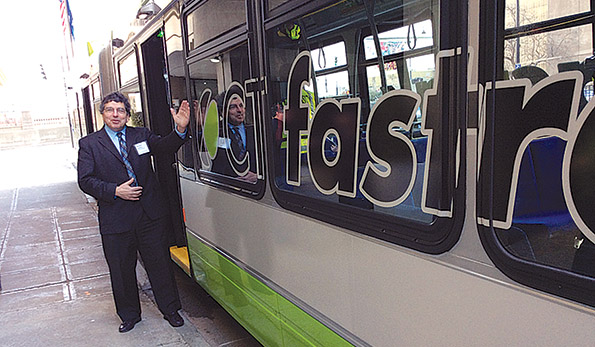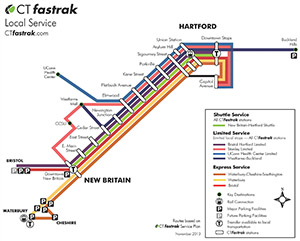
By Michael Sanders
Connecticut Department of Transportation Transit Administrator
Bus Rapid Transit (BRT) systems like the CTfastrak system, currently under construction between downtown New Britain and downtown Hartford, offer a high-quality rapid transit experience that is gaining in popularity for ease-of-use, speed and frequency of service, and incorporation of the latest technology and passenger amenities.
—————————————————————————————————————————————
YOU MIGHT ALSO LIKE:
- Stay ahead of the curve with transit restraints
- VTA connects with Allied Telesis
- UTA goes EasyandOpen with Vix Technology
—————————————————————————————————————————————
CTfastrak is born
The regional highway system around Hartford, CT, especially the corridor west of Hartford on I-84, has long experienced significant traffic congestion. Because it met congestion goals in the most cost-effective way, BRT was the locally preferred alternative. The Council created CTfastrak to help manage congestion, facilitate economic redevelopment, promote the state’s smart growth initiatives and bring activity back to this old industrial corridor.
Running Way/Operating Method
CTfastrak will use an exclusive 9.4-mile dedicated, bus-only roadway to speed bus travel throughout the New Britain and Hartford region, separating the reliable bus service from mixed traffic. CTfastrak travel time will be competitive with current auto and transit travel in the corridor, provide better service to existing transit customers and attract new riders to the system who might otherwise drive.

CTfastrak stations
CTfastrak will have limited stops at 10 stations along the guideway approximately one mile apart, which will include shelters with seating, bicycle racks, ticket vending machines, maps of routes and the surrounding neighborhood and landscaping. These elevated platforms will allow fast, level boarding onto the buses. Electronic displays at each station will let passengers know when their bus will be arriving and closed circuit cameras at the stations will enhance passenger security.
CTfastrak rolling stock
A mix of transit buses and commuter coaches will serve CTfastrak. All buses will be super-low-emission hybrid diesel-electric-powered and use less fuel.
60-foot articulated vehicles will be the flagship of the CTfastrak fleet and will operate the frequent shuttle service along the CTfastrak mainline. These buses will feature multiple boarding doors, low floors, expedited wheelchair boarding technology and on-board bike provisions to speed boarding.
CTfastrak services will also use 45-foot commuter coaches to provide service on the long-distance routes that use the limited-access highway system to reach destinations off the guideway.
40-foot transit buses will run on services that extend along the guideway for part of their route then run on local streets to major off-guideway destinations. 30-foot buses will operate connecting services with an easy transfer to reach out into the local communities, providing connections to major destinations and to better serve neighborhoods beyond walking distance of stations.
Like other BRT systems, CTfastrak vehicles will have their own unique identity; distinguishable from the other transit services in the CTtransit system through the use of vehicle wraps and color schemes – and will come equipped with Wi-Fi.
Fare collection
CTfastrak will use electronic fare collection with ticket vending machines at stations along the guideway. This allows passengers to pre-purchase fares using cash, credit cards and future payment methods that may come along that do not require exact change and without paying on the bus itself.
Intelligent Transportation Systems
CTfastrak will use a variety of Intelligent Transportation Systems (ITS) technology upgrades not currently available on the CTTransit bus system. This will include an Automatic Vehicle Location (AVL) system that transmits the exact location of the vehicles via satellite GPS or radio signals, allowing riders to receive real-time information on the next bus arrival or next bus stop, and enabling transmission of text alerts and travel information to phones. A computer aided dispatch system will provide constant communication between CTfastrak vehicles and the operations center to monitor performance and keep vehicles running on schedule. ITS elements will be used in a variety of ways on the bus and at stations and include bus arrival/departure information, audio/visual displays, security equipment, and pedestrian crossing signals. Traffic signal preference will also be used at the five at-grade intersections along the CTfastrak guideway to improve travel time.
Community benefits
The CTfastrak project created or sustained approximately 4,000 construction jobs annually and will create more than 150 permanent jobs. The attraction of a one-seat ride from outlying communities to downtown New Britain and Hartford will be combined with new connections that will allow for significantly improved access to suburban employment centers, educational institutions, healthcare (including three public hospitals and a VA hospital), shopping and cultural attractions. This will result in better utilization of the region’s overall transit highway capacity and improved coordination between the modes including the local and commuter express bus service, inter-city bus service and commuter and inter-city rail.
The flexibility of CTfastrak operations will allow the transit system to more effectively respond to changing ridership demands and future development within the corridor. Towns directly affected by the project will be encouraged to commence more smart–growth initiatives oriented to the new rapid transit infrastructure.
